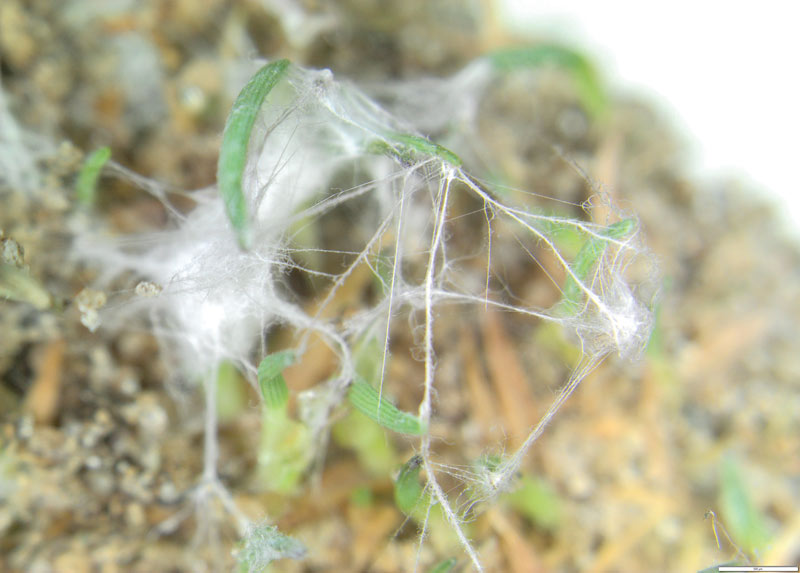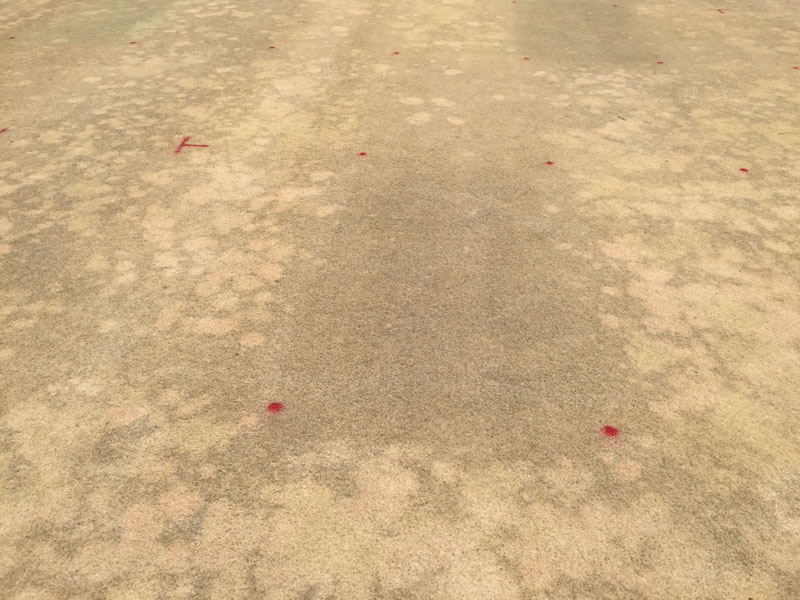
Figure 1. On bermudagrass putting greens, the symptoms of cream leaf blight start as small white or cream spots or patches that range in size from 3 to 8 inches (7.6-20.3 cm) in diameter. Photos by Lee Butler
Cream leaf blight was discovered in tall fescue swards in Georgia by university researchers who isolated Limonomyces roseipellis from tall fescue exhibiting white lesions that expand toward the base of the leaf. In tall fescue landscapes, cream leaf blight is a rare occurrence, yet the fungus affects ultradwarf bermudagrasses (Cynodon dactylon × C. transvaalensis) planted on golf course putting greens too.
Little is known about the disease on bermudagrass putting greens, but we commonly observe it in the transition zone and even into northern Florida. However, the disease is most prevalent in areas where bermudagrass goes dormant. The disease rose to prominence in the Southeast as the conversion from creeping bentgrass (Agrostis stolonifera) putting greens to ultradwarf bermudagrass increased.
We suspect that the disease has been present for some time and was likely diagnosed as superficial fairy ring, pink patch or some other basidiomycete fungus. As golf course superintendents were working out winter management practices, cream leaf blight was alarming, as it could span large areas of putting greens quickly, yet the disease never seemed to cause any serious damage.
Cream leaf blight symptoms and signs
On bermudagrass putting greens, the symptoms start as small white or cream spots or patches ranging in size from 3 to 8 inches (7.6-20.3 cm) in diameter (Figure 1, above). The patches rarely increase in size, but may coalesce into larger areas. The disease is cosmetic, as we have observed little lasting damage associated with the disease, yet it can affect large areas of turf. The stand symptoms can be difficult to see when bermudagrass is painted or pigmented during the winter months. Symptoms have been observed across entire putting greens during the winter months.
Affected leaves have a cream to whitish appearance, but no visible lesions can be found on the leaves. No symptoms or signs are observed on stolons, rhizomes or roots. Unlike with pink patch and some other fungal diseases, no aerial mycelium has been observed with this disease.
The cream leaf blight pathogen
The pathogen is Limonomyces roseipellis, the same organism that causes pink patch in cool-season turfgrasses. However, the biotype associated with cream leaf blight does not produce clamp connections and does not have a pinkish or reddish appearance on the leaf.

Figure 2. The fungus Limonomyces roseipellis produces hyphal aggregates after incubation of bermudagrass samples. The hyphal aggregates are visible only with a dissecting microscope.
The fungus readily produces hyphal aggregates after incubation of bermudagrass samples, and the absence of clamp connections is obvious (Figure 2, above). The hyphae themselves are hyaline and are binucleate. In our experience, the fungus sometimes readily grows out of leaf tissue after 24 hours, but at other times, it is slow to produce the diagnostic hyphal aggregates.
Conditions favoring disease
The fungus is able to grow at a wide range of temperatures. Growth of the fungus has been observed from 40 F to 90 F (4 C-32 C), but optimal growth in culture is between 68 F and 77 F (8 C-20 C) (3). That being said, it seems that the biotype observed on ultradwarf bermudagrass grows best at the lower temperature range. In particular, cream leaf blight is most severe on bermudagrass that has been covered during the winter months. This fits with the description of the fungus, as it typically is most severe when turf is slow-growing, because it is a slow-growing fungus. Although the disease is most prevalent during winter, we have observed it in summer during extended periods of rain and cloud cover.
Cream leaf blight management
Management of cream leaf blight has been relatively simple. Fungicides work well, and a few have been exceptional in our experience. Cream leaf blight did not develop in any of our fungicide trials until 2016, so before then we relied on feedback from superintendents on what was working. A number of people reported that iprodione worked well curatively. Curative applications are made after significant stand symptoms are present. Many superintendents said that Prostar (flutolanil, Bayer) was also excellent. One superintendent reported spraying a combination of iprodione and Prostar, which rapidly knocked out the disease. If curative applications are warranted, do not water in the products, as the fungus harbors itself in the foliage. Other fungicides may be effective too, but we have not carried out a curative trial on this disease.

Figure 3. Preventive applications of fungicides in fall typically work extremely well against cream leaf blight.
Preventive applications work extremely well against cream leaf blight (Figure 3). We have gathered this data mainly in our spring dead spot trials. Typically, we make these applications in fall when soil temperatures decline to 70 F (21 C), and we make a follow-up application 28 days later. The past three falls, we have not reached these soil temperatures until mid- to late October. In our trials, all applications are irrigated immediately with 0.125 inch (3.2 mm) of water. Applications of Velista (penthiopyrad, Syngenta); Lexicon (fluxapyroxad, BASF); Enclave (chlorothalonil, iprodione, thiophanate-methyl, tebuconazole; Quali-Pro); Briskway (azoxystrobin, difenoconazole; Syngenta); Headway (azoxystrobin, propiconazole; Syngenta); Strobe (azoxystrobin, Quali-Pro) + propiconazole; Fame T (fluoxastrobin, tebuconazole; FMC Corp.); and Torque (tebuconazole, Cleary Chemicals) all suppressed cream leaf blight when it developed in January and February in the non-treated controls. Tebuconazole and other demethylation inhibitors have not provided consistent control in our trials, however. In one trial, tebuconazole suppressed cream leaf blight, but in an adjacent trial, it did not control the disease (2).
It is noteworthy that the last applications performed in many of these trials were around Nov. 15. Thus, superintendents will control cream leaf blight with fungicides that are targeting spring dead spot. We are not sure whether applications targeting take-all root rot will control cream leaf blight, although they likely will, as the timings seem to align well with spring dead spot. We have not, however, observed activity of Tartan Stressgard (trifloxystrobin, triadimefon; Bayer) on cream leaf blight, even though it has been an excellent preventive treatment for take-all root rot. Thankfully, we have seen excellent results with other strong take-all root rot products such as Lexicon and Briskway. Phosphites may also limit the development of the disease, but we currently do not have any data to support that assumption.
Little is known about the cultural management of cream leaf blight. We suspect that we will not learn much more about the biology of this fungus until it becomes a bigger issue. Given that the disease is most prevalent during winter, especially on slow-growing or dormant turf, fungicides may be the best option for managing it.
Currently, we suggest that superintendents make fall applications of fungicides used to manage spring dead spot and take-all root rot, as these diseases can be destructive. Based on those applications, other fungicides may be warranted as bermudagrass greens are covered during periods of extreme cold. Typically, we suggest applying chlorothalonil, iprodione or mancozeb before covering greens to ensure that fungi do not proliferate under the covers.
Cream leaf blight is an interesting disease of bermudagrass putting greens and tall fescue landscapes. It is a relatively minor disease of putting greens, but it can span large areas quickly. The disease remains a cosmetic issue, but often relatively minor diseases can become more problematic as environmental conditions or management practices change over time.
Superintendents who suspect cream leaf blight on their golf course should submit a sample to a local diagnostic lab. After proper diagnosis, management of this disease is straightforward. Do get a diagnosis, however, as white patches on bermudagrass putting greens are symptomatic of many different diseases. Symptoms of cream leaf spot could potentially be confused with take-all root rot or initial symptoms of spring dead spot or root-knot nematode.
Funding
This work is supported by the Center for Turfgrass Research and Education at North Carolina State University and the North Carolina Agricultural Research Station.
The research says ...
- Cream leaf blight is a disease of ultradwarf bermudagrass caused by the pathogen Limonomyces roseipellis, the same organism that causes pink patch in cool-season turfgrasses.
- Although patches of diseased grass may rapidly cover a green, the disease appears to be largely cosmetic and causes little lasting damage.
- The fungus is seen at a wide range of temperatures, but grows best at lower temperatures (40 F) and is most severe in winter on bermudagrass protected by a putting green cover.
- Several common fungicides have provided good preventive control when applied in fall. No curative trials have taken place.
Literature cited
- Burpee, L.L., C.W. Mims, L.P. Tredway, J. Bae and G. Jung. 2003. Pathogenicity of novel biotype of Limonomyces roseipellis in tall fescue. Plant Disease 87:1031-1036. doi:10.1094/PDIS.2003.87.9.1031
- Kerns, J.P., E.L. Butler, M.D. Soika and J.N. Ploetz. 2017. Effects of Velista and Briskway programs on control of spring dead spot on a bermudagrass putting green, 2015-2016. Plant Disease Management Reports 11:T020.
- Smiley, R.W., P.H. Dernoeden and B.B. Clarke. 2005. Compendium of turfgrass diseases. The American Phytopathological Society, St. Paul, Minn.
Jim Kerns is an associate professor and Lee Butler is Extension coordinator in the Department of Entomology and Plant Pathology, North Carolina State University, Raleigh, N.C.